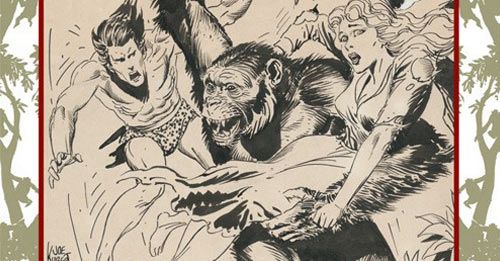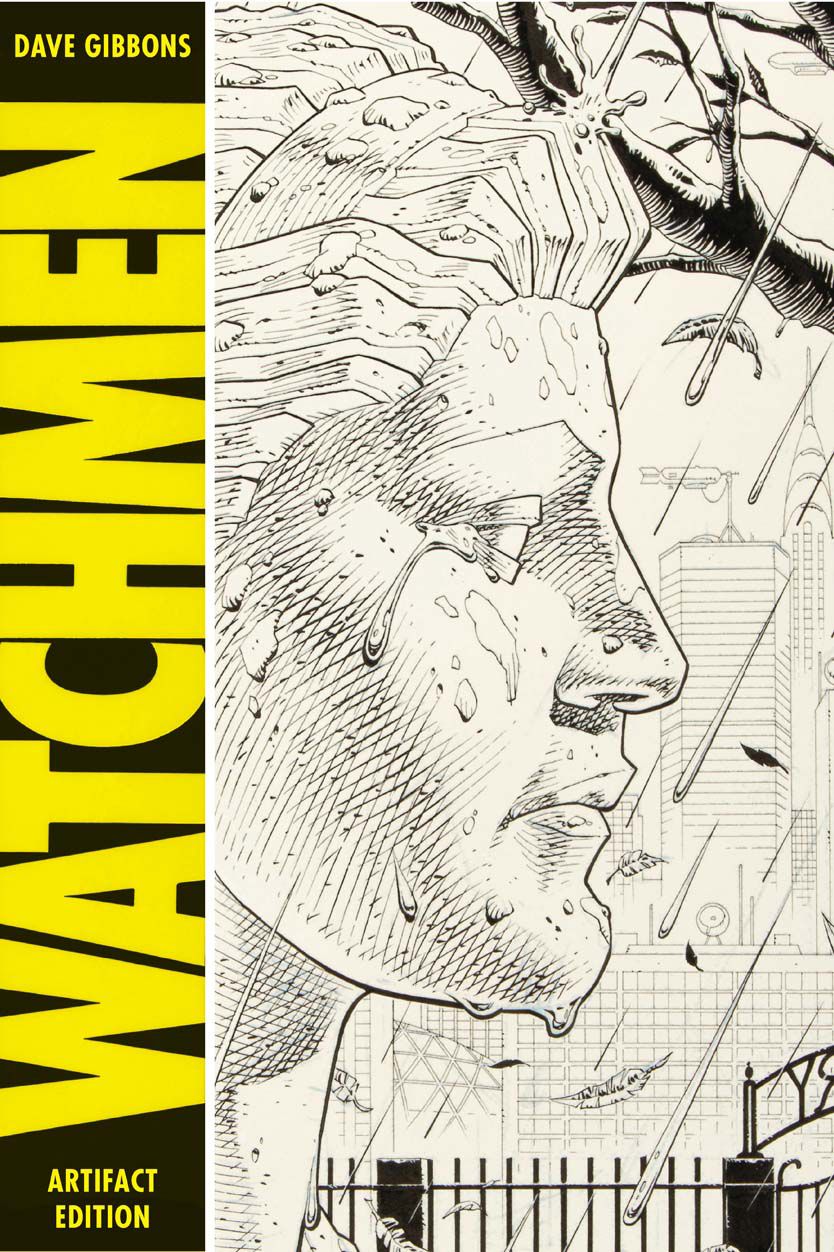On Thursday afternoon at Comic-Con International in San Diego, IDW Publishing's Chief Operating Officer Greg Goldstein moderated a discussion about their award-winning Artist's Edition line. Artist's Editions recreate classic comic book art in its purest form by scanning in an artist's original black-and-white pages before they are colored and retouched for publication, allowing readers to see everything from white-out mistakes to notes in margins. Joining Goldstein on the panel were IDW special projects editor and Artist's Edition mastermind Scott Dunbier alongside renowned creators Walt Simonson and Dave Gibbons.
"I'm the very proud publisher of over 21 Artist's Editions as of today," said Goldstein before handing the reigns over to Dunbier to discuss IDW's recent and upcoming Artist's Editions. The newest Artist's Editions on sale is the "Nick Fury: Agent of S.H.I.E.L.D. Artist's Edition" by Jim Steranko. "There have been some large, over-sized Artist's Edition books before, some DC stuff," Dunbier said, "but this was the first large Marvel book and people weren't quite prepared for it. I saw a lot of tweets from various people saying it's a nice book but maybe they're going to have to see a chiropractor." Dunbier also pointed out that Steranko was in attendance at Comic-Con so fans could get their copies of "Nick Fury" signed.
SDCC: IDW Publsihing Rocks San Diego
Moving on, Dunbier displayed the cover for "Hellboy Artist's Edition" by Mike Mignola. "This is just 200 pages of beautiful Mike Mignola artwork," said Dunbier.
Dunbier then revealed that IDW's shipment of the "Watchmen Artifact Edition" was :lost at the port," so he'd be checking his phone all panel waiting for confirmation that the books had finally made it to the show. The shipment ended up arriving about 20 minutes into the panel, to Dunbier's relief. "Watchmen Artifact Edition" is another brand new release. Dunbier displayed pages from the book and pointed out that you can see the name 'Neil' clearly written in the gutter. Gibbons revealed it stood for 'Neil Gaiman,' because the page had been given to Gaiman as thanks for helping [Alan Moore and Gibbons] out on "Watchmen."
"Neil [Gaiman] was very helpful to us when we were making 'Watchmen' because Alan [Moore] would have an idea of a quotation from English literature that he barely vaguely knew," said Gibbons. "He'd call up Neil and he'd immediately be able to tell [Alan] exactly where the quote was from."
The next book spotlighted was "Stephen King's Lawnmower Man Artist's Portfolio" by Simonson. Simonson said he and King made the book "Marvel style," meaning Simonson would draw the art first and then King would write a script based on it. Looking at the pages on-screen, Simonson revealed he "had to go through and erase a ton of Stephen King hand-writing in order to clean the pages up around the edges [for printing] and it just killed me."
RELATED: Simonson Teams with Stephen King for IDW's "Lawnmower Man Artist's Edition"
Dunbier appeared particularly happy to present the next title, "Manhunter and Other Stories Artist's Edition." "'Manhunter,' as probably everybody in the world knows by now, is one of my all-time favorite things," said Dunbier. When I was a kid I had three favorite comics. 'Manhunter,' 'Joe Kubert's Tarzan' and another one I won't mention right now. So far I've been able to do two out of my three absolute comics when I was ten years-old. And I'm going to be doing the third one sometime next year."
Dunbier next displayed covers for upcoming releases "Will Eisner's The Spirit Artist's Edition Volume 2" and "Silver Surfer Artist's Edition" by artist John Buscema. Dunbier called Buscema "one of the classic Marvel artists from the 1960s."
IDW's third Joe Kubert book is an "Enemy Ace Artist's Edition." Gibbons said his favorite Kubert Artist's Edition was "Tor" and Dunbier called the legendary artist's work "fearless."
The panel then moved on to its first announcement: "Jack Kirby's Mister Miracle Artist's Edition." Dunbier said the book would contain seven issues of "primetime material" including issues #2, #3 and #5-9. "Jack Kirby. What more do you need to say?"
The final announcement was an unexpected one: "Eric Powell's The Goon Artist's Edition" featuring the "Chinatown" series. Powell then joined the panelists on stage as a surprise guest. "What I love about Artist's Editions is it's all sorts of different styles and all sorts of different books, but the common denominator is it's all great work," said Dunbier. "Every single book, to me, is by an incredibly talented creator and Eric [Powell] certainly falls into that category."
Powell said the black and white Artist's Edition format was perfect for "The Goon." "'Chinatown' is one of the few things that I colored digitally myself but the work I put into the actual pages, the coloring actually detracts a little bit," said Powell. "I had so much greytone on the pages that the color didn't show. I layered it in really light. I didn't want to have a saturated book, I wanted it a little washed out."
The panel then opened up to questions from the audience though Goldstein himself asked the first question, wondering which piece of artwork they'd have to pry from Dunbier's "cold, dead hands." Dunbier said there were two. The first is a drawing of Captain America that Jack Kirby drew for him as a child. As a kid, Dunbier looked Kirby's number up through directory assistance and cold-called the King of Comics. Surprisingly, Kirby invited Dunbier to his house for lunch, signed a bunch of comics and drew Dunbier the Captain America sketch. Dunbier's other prized piece of artwork is a two-page sequence from "Will Eisner's The Spirit" lettered by Wally Wood, which he said took him years to track down.
Asked how he got the idea for the Artist's Edition line, Dunbier said it came to him in the early '90s when he made photocopies of original art for pamphlets. He discovered that the black-and-white copies looked terrible while the color copies looked great, despite the artwork itself being primarily black and white. "I wound up making hundreds of color photocopies in the 1990s. Think about how much color copies cost back then!" Dunbier said with a laugh. "It was not the brightest move but it looked so much better. That's what I sort of consider my first Artist's Edition."
Goldstein asked each member of the panel what the first piece of original artwork they saw in person was. Simonson saw pages of Joe Kubert's "Viking Prince" on sale for $40 a page at the 1969 World Science Fiction Convention. "It might have well been a million dollars to me in 1969," said the writer/artist.
Gibbons couldn't remember the first piece of artwork he'd ever seen, but did say he'd get dozens of pages of random original art when he was working for a UK magazine in the '70s. He studied the pages to hone his art technique.
RELATED: SDCC: "Big Trouble in Little China": Shaking the Pillars of the Comics Industry
Powell revealed his sister's boyfriend took him to a comic convention at a young age where he met a DC Comics inker. After marveling at the artist's original art Powell asked the inker if he "could ever get a chance to work in comics. He just said no. One word response. I was maybe 14."
A fan then asked Dunbier if he had any good stories about working with the late Joe Kubert. Dunbier said that even though Kirby was near death, he refused to stop drawing sketch cards for the "Tarzan Artist's Edition." "I told [Kubert's representative] that [the sketch cards] didn't matter. He said, 'Men Asked how they decided which Artist's Editions would sell, Goldstein replied, "Believe it or not, we don't ask ourselves, 'Will this book sell?' The first question we ask is do we want to publish this artist because they're a great storyteller and a great artist. That has been the primary driver, not knowing from the beginning how many [Artist's Edition] would sell."
Stay tuned to CBR News for more on IDW's Artist's Editions.


